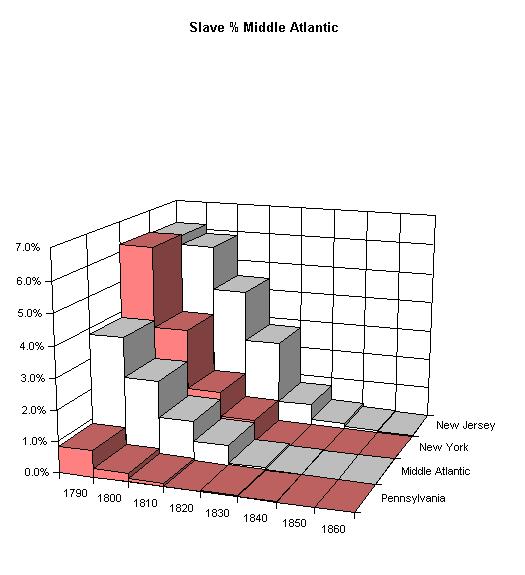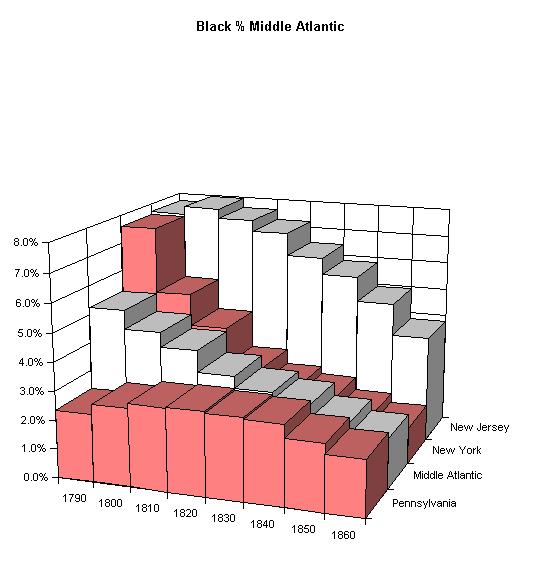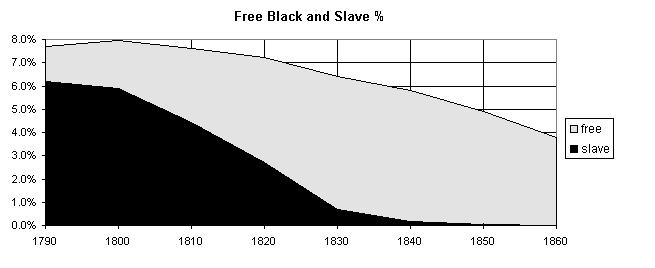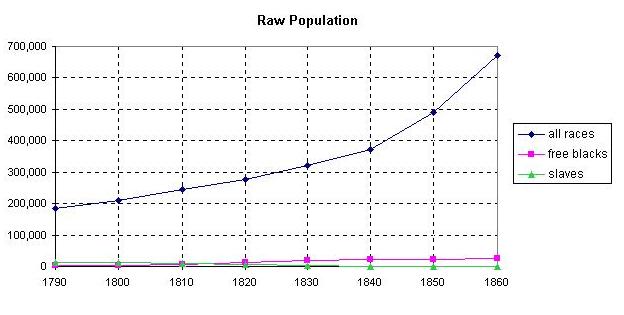
BLACK DEMOGRAPHIC DATA, 1790-1860
A SOURCEBOOK
CLAYTON E. CRAMER
Preface vii 1 Limitations of Census Data 1 2 Emancipation 7 3 Manumission 19 4 Internal Immigration Restrictions 31 5 Disabilities, Slave-Dumping, and The 1840 Census 43 6 International Black Migration 51 7 Tables and Graphs 63 Bibliography 155 Index 161
To test that hypothesis, I went looking for percentages of free black population by state. While raw census data were easy to find, it was not so easy to find free black percentages by state. True, I could compute them easily enough, but that was not my primary interest at the time. Even a table of percentages for any particular census was not really what I wanted. When most people look for trends, a table of percentages is much less convenient to read than a graph. This is why I have produced this volume of tables and graphs.
Who will use this book? Writers of history books will find the graphs a useful way to communicate the changing nature of the American black population before the Civil War. Some historians will find this work useful for exactly the same reason that I did-to find quickly statistical evidence that might either support or disprove a hypothesis. It is my hope, however, that historians will find that the enclosed data provoke new questions about the status of blacks in antebellum America.
Along the way, a number of people have provided much needed assistance, sometimes unwittingly, in the production of this book. The enthusiastic response of Professor LeVell Holmes of Sonoma State University to a paper about disabled slaves and immigration restrictions of the Old Northwest caused me to pursue this subject. Professors Robert Forbes of Yale and Daniel Markwyn of Sonoma State University have provided encouragement and advice throughout the later phases of this project. Professor John David Smith at North Carolina State University carefully reviewed the manuscript for Greenwood; he gave me a number of useful suggestions that enhanced my examination of internal immigration restrictions. Laura Clark, my editor at Greenwood, tactfully guided me through the sometimes complex process of bringing the text and layout into a final form appropriate for publication. My wife, Rhonda, was an invaluable help with criticism when my writing crossed the line from scholarly to obscure. Finally, Cliff Cousins and Alan Denney did the final proofreading before publication.
The decennial census data has its own set of problems. Even today, the Census Bureau undercounts the black population of the United States, along with other racial minorities, in spite of considerable effort otherwise. (The reasons for contemporary undercounting, and the efforts to correct it, have been the subject of considerable political debate and some academic study.) It is entirely reasonable to assume that the antebellum censuses undercounted blacks (both free and slave) as well. Besides the problems the Census Bureau encounters today, antebellum censuses suffered difficulties peculiar to slavery. Runaway slaves would have been reluctant to identify themselves to census officials for fear of being returned to their masters. Even before the Fugitive Slave Act of 1850, runaway slaves in the North were at considerable risk of being returned to slavery. Even blacks who were born free, or whose masters had lawfully freed them, were at risk of being kidnapped and enslaved by slave catchers.
Another cause of census undercounting is that before 1790, and again after 1820, most slave states severely restricted the authority of masters to free their slaves. For a variety of reasons, masters sometimes freed slaves anyway, or sold or willed slaves to a trustee, who treated them as free. We would certainly consider these quasi-free slaves to be "free," as many considered themselves to be, thus leading to their misclassification by the census. But because of their illegal status, these quasi-free blacks would also have done their best to avoid the census officials for fear that their illegally freed status might land them back in bondage. For these reasons, Ira Berlin asserts, "[I]t is my belief that the census underestimates the Southern free Negro population by at least 20 percent."[3] But Berlin gives no statistical evidence for that belief.
Another interesting variant of slavery that might influence the accuracy of the censuses was "term slavery." Primarily a quirk of the District of Columbia, masters sometimes granted slaves their freedom contingent on reaching a certain age or completing a particular term of service. In some cases, masters advertised term slaves for sale with a specified period of years remaining.[4]
Some blacks sought to escape legal and societal restrictions by passing as white or Indian. If they had successfully misled their neighbors, it seems unlikely that the census marshals would receive a more accurate statement. It would have been relatively easy for some light-skinned blacks to move into a community and be accepted as white. William Lincoln, a student at Oberlin College in Ohio, made a series of journeys into the Upper South in the late 1850s preaching abolitionism. On one such journey: "Lincoln was asked to guess the race of the male parishioners as they entered the church. `I made 11 mistakes in 15 minutes,' Lincoln acknowledged. Apparently, work outdoors in the sun and wind had tarnished the face and hands of the men. `One case, were I put on oath, I [should] still affirm to be colored,' Lincoln said."[5]
An additional source of confusion in recording racial statistics is the ambiguous local definitions of "black." Most Southern states used Virginia's 1785 statutory definition: that even one African ancestor in the previous two generations made one a "Negro." Other states went back to the third or even fourth generation looking for black ancestors. A short-lived Ohio statute prohibiting black voting defined race as the "visible admixture" of black blood--an imprecise definition at best. An 1850 California statute prohibited blacks and Indians from testifying in cases involving whites, and defined blacks as "one eighth part or more of Negro blood." South Carolina, however, never drew the color line by statute, though judges "generally drew the line between white and black at somewhere between a quarter and an eighth Negro ancestry." But if a person of mixed race appeared to be white, and was socially accepted as white, South Carolina judges often treated him as white. Many blacks of mixed Indian and African ancestry benefited from being able to call themselves Indian.[6]
One especially extreme example of the problems of trusting the census racial definitions (which were usually based on local usage) is Jack Coon of Alabama. In 1850, a federal census marshal listed him as white. A state census the same year listed him as a mulatto freeman. The 1860 federal census listed Coon as an Indian.[7]
Another problem was the confused racial origins of many Americans. Consider the Sumter Turks of South Carolina. Perhaps of Middle Eastern origin, they settled in South Carolina in the eighteenth century. In 1790, they petitioned the state legislature to be treated as whites, and not as blacks, insisting they were "subjects of the Emperor of Morocco." While they insisted that they were white, whites of European origin in the region did not share this opinion, and the 1830 census recorded a number of them as free blacks.[8]
Would there have been incentives to intentionally underreport the number of free or slave blacks? No, because the census numbers determined the number of representatives each state received in the House of Representatives. Free blacks counted the same as whites for this purpose, and slaves (euphemistically referred to in the U.S. Constitution as "all other persons") counted as three-fifths of a free person.[9] At the same time, each state was master of who was allowed to vote. Free blacks and slaves could be safely counted for purposes of representation, with no danger of them voting. Thus, states both North and South would have sought to maximize their count of both free and slave blacks.
Statistics have a tremendous power over the human mind. Many people will accept the most bizarre assertions if these assertions are backed up by a sufficiently impressive body of statistics. This is no surprise; part of what distinguishes natural science from many other fields that call themselves "sciences" is quantifiable experimental data.
At first glance, the statistical information that comprises the latter three-fourths of this book gives a similar illusion. It is important to remember, however, that unlike physics, or even physiological psychology, survey data are not experimental data. The act of surveying a population, and for what purpose that survey is taken, can affect the accuracy of the data. Historians must always remember that in human affairs, volition makes all survey data less than perfect.
[1] Ira Berlin, Slaves Without Masters: The Free Negro in the Antebellum South (New York: Pantheon Books, 1974), 46-47.
[2] Hyman Alterman, Counting People: The Census in History (New York: Harcourt, Brace & World, Inc., 1969), 163-171. See U.S. Bureau of the Census, Historical Statistics of the United States, Colonial Times to 1970, Bicentennial Edition (Washington: Government Printing Office, 1975), 1169-1171 (hereinafter, Historical Statistics of the United States) for a list of colonial censuses. A more detailed source (but a bit harder to find) is Evarts B. Greene and Virginia D. Harrington, American Population Before the Federal Census of 1790 (New York: Columbia University Press, 1932; reprinted Gloucester, Mass.: Peter Smith, 1966).
[3] Berlin, 49, 145, 175; Marina Wikramanayke, A World in Shadow: The Free Black in Antebellum South Carolina (Columbia, S.C.: University of South Carolina Press, 1973), 39-42.
[4] Letitia Woods Brown, Free Negroes in the District of Columbia: 1790-1846 (New York: Oxford University Press, 1972), 87-89.
[5] Nat Brandt, The Town That Started the Civil War (Syracuse, N.Y.: Syracuse University Press, 1990), 9-11.
[6] Berlin, 97-99, 163-164. Eric Foner, Free Soil, Free Labor, Free Men: The Ideology of the Republican Party Before the Civil War (New York: Oxford University Press, 1970), 286; Rudolph M. Lapp, Afro-Americans in California, 2d ed. (San Francisco: Boyd & Fraser Publishing Co., 1987), 7-8. As Jefferson noted in 1815, a person might be white under the law, and yet still be a slave, because slavery depended "on the condition of the mother." Thus, many of the Hemings children on the Jefferson estate were legally both white and slave. Lucia C. Stanton, "`Those Who Labor for My Happiness': Thomas Jefferson and His Slaves," in Peter S. Onuf, ed., Jeffersonian Legacies (Charlottesville, Va.: University Press of Virginia, 1993), 152-153.
[7] Berlin, 161.
[8] Michael P. Johnson and James L. Roark, Black Masters: A Free Family of Color in the Old South (New York: W.W. Norton & Co., 1984), 145-147; Wikramanayke, 20-21.
[9] U.S. Const., Art. I, SS 2, cl. 3.
Middle Atlantic
| state | 1790 | 1800 | 1810 | 1820 | 1830 | 1840 | 1850 | 1860 |
| New York | 1.4% | 1.8% | 2.6% | 2.1% | 2.3% | 2.1% | 1.6% | 1.3% |
| New Jersey | 1.5% | 2.1% | 3.2% | 4.5% | 5.7% | 5.6% | 4.9% | 3.8% |
| Pennsylvania | 1.5% | 2.4% | 2.8% | 2.9% | 2.8% | 2.8% | 2.3% | 2.0% |
| Middle Atlantic | 1.5% | 2.1% | 2.8% | 2.7% | 2.8% | 2.6% | 2.1% | 1.8% |

| state | 1790 | 1800 | 1810 | 1820 | 1830 | 1840 | 1850 | 1860 |
| New York | 6.2% | 3.5% | 1.6% | 0.7% | 0.0% | 0.0% | 0.0% | 0.0% |
| New Jersey | 6.2% | 5.9% | 4.4% | 2.7% | 0.7% | 0.2% | 0.0% | 0.0% |
| Pennsylvania | 0.9% | 0.3% | 0.1% | 0.0% | 0.0% | 0.0% | 0.0% | 0.0% |
| Middle Atlantic | 3.8% | 2.5% | 1.3% | 0.7% | 0.1% | 0.0% | 0.0% | 0.0% |

| state | 1790 | 1800 | 1810 | 1820 | 1830 | 1840 | 1850 | 1860 |
| New York | 7.6% | 5.3% | 4.2% | 2.9% | 2.3% | 2.1% | 1.6% | 1.3% |
| New Jersey | 7.7% | 8.0% | 7.6% | 7.2% | 6.4% | 5.8% | 4.9% | 3.8% |
| Pennsylvania | 2.4% | 2.7% | 2.9% | 2.9% | 2.8% | 2.8% | 2.3% | 2.0% |
| Middle Atlantic | 5.2% | 4.6% | 4.1% | 3.3% | 2.9% | 2.6% | 2.1% | 1.8% |

New Jersey
| status | 1790 | 1800 | 1810 | 1820 | 1830 | 1840 | 1850 | 1860 |
| slave | 6.2% | 5.9% | 4.4% | 2.7% | 0.7% | 0.2% | 0.0% | 0.0% |
| free | 1.5% | 2.1% | 3.2% | 4.5% | 5.7% | 5.6% | 4.9% | 3.8% |

| status | 1790 | 1800 | 1810 | 1820 | 1830 | 1840 | 1850 | 1860 |
| all races | 184,139 | 211,149 | 245,562 | 277,575 | 320,823 | 373,306 | 489,555 | 672,035 |
| free blacks | 2,762 | 4,402 | 7,843 | 12,460 | 18,303 | 21,044 | 23,810 | 25,318 |
| slaves | 11,423 | 12,422 | 10,851 | 7,557 | 2,254 | 674 | 236 | 18 |

Bennett, Pamela J., and Shirley S. McCord. Progress After Statehood: A Book of Readings (Indianapolis: Indiana Historical Bureau, 1974).
Berlin, Ira. Slaves Without Masters: The Free Negro in the Antebellum South (New York: Pantheon Books, 1974).
Berwanger, Eugene H. The Frontier Against Slavery: Western Anti-Negro Prejudice and the Slavery Extension Controversy (Urbana, Ill.: University of Illinois Press, 1967).
Bickford, Charlene Bangs, and Helen E. Veit, ed. Documentary History of the First Federal Congress of the United States of America (Baltimore: Johns Hopkins University Press, 1986).
Bonomi, Patricia U. Under the Cope of Heaven: Religion, Society, and Politics in Colonial America (New York: Oxford University Press, 1986).
Brackney, William H. The Baptists (Westport, Conn.: Praeger, 1994).
Brandt, Nat. The Town That Started the Civil War (Syracuse, N.Y.: Syracuse University Press, 1990).
Brown, Letitia Woods. Free Negroes in the District of Columbia: 1790-1846 (New York: Oxford University Press, 1972).
Bruns, Roger, ed. Am I Not A Man And a Brother: The Antislavery Crusade of Revolutionary America, 1688-1788 (New York: Chelsea House, 1977).
Bureau of the Census. Negro Population in the United States 1790-1915 (Washington: Government Printing Office, 1918; reprinted New York: Arno Press, 1968).
Census for 1820 (Washington: Gales and Seaton, 1821; reprinted New York: Central Book Co., n.d.)
Cohen, Patricia Cline. A Calculating People: The Spread of Numeracy in Early America (Chicago: University of Chicago Press, 1982).
Compendium of the Enumeration of the Inhabitants and Statistics of the United States (Washington: Thomas Allen, 1841; reprinted New York: Central Book Co., n. d.).
Conmy, Peter Thomas. The Constitutional Beginnings of California (San Francisco: Dolores Press, 1959).
Cottrol, Robert J., and Raymond T. Diamond. "The Second Amendment: Toward an Afro-Americanist Reconsideration," Georgetown Law Journal 80:2 (December, 1991).
Cramer, Clayton E. For the Defense of Themselves and the State: The Original Intent and Judicial Interpretation of the Right to Keep and Bear Arms (Westport, Conn.: Praeger, 1994).
________. "The Racist Roots of Gun Control," Kansas Journal of Law and Public Policy 4:2 (Winter, 1995), 17-25.
Curtin, Philip D. The Atlantic Slave Trade: A Census (Madison, Wisc.: University of Wisconsin Press, 1969).
DeBow, J.D.B. Statistical View of the United States (Washington: Beverley Tucker, 1854; reprinted New York: Central Book Co., n. d.).
de Tocqueville, Alexis. Democracy in America, Phillips Bradley, ed. (New York: Vintage Books, 1945).
Deutsch, Albert. "The First U.S. Census of the Insane (1840) and Its Use as Pro-Slavery Propaganda," The Bulletin of the History of Medicine 15:5 (May, 1944), 469-482.
Du Bois, W. E. Burghardt. The Suppression of the African Slave-Trade to the United States, 1638-1870 (1896; reprinted New York: The Social Science Press, 1954).
Enumeration of the Inhabitants of the United States, 1830 (Washington: Duff Green, 1832).
"Errors in Sixth Census," House Report, 28 Cong., 1 sess., No. 580 (1844).
Finkelman, Paul. "Jefferson and Slavery: 'Treason Against the Hopes of the World'," in Peter S. Onuf, ed. Jeffersonian Legacies (Charlottesville, Va.: University Press of Virginia, 1993), 181-221.
Fitzhugh, George. Cannibals All!, C. Vann Woodward, ed. (Cambridge, Mass.: Harvard University Press, 1960).
Fogel, Robert William, and Stanley L. Engerman. Time on the Cross: The Economics of American Negro Slavery (Boston: Little, Brown and Co., 1974).
Foner, Eric. Free Soil, Free Labor, Free Men: The Ideology of the Republican Party Before the Civil War (New York: Oxford University Press, 1970).
________, ed. Nat Turner (Englewood Cliffs, N.J.: Prentice-Hall, Inc., 1971).
Franklin, Frank George. The Legislative History of Naturalization in the United States: From the Revolutionary War to 1861 (Chicago: University of Chicago Press, 1906; reprinted New York: Arno Press, 1969).
Greene, Evarts B., and Virginia D. Harrington. American Population Before the Federal Census of 1790 (New York: Columbia University Press, 1932; reprinted Gloucester, Mass.: Peter Smith, 1966).
Gutman, Herbert G. Slavery and the Numbers Game: A Critique of Time on the Cross (Urbana, Ill.: University of Illinois Press, 1975).
Hembree, Michael F. "The Question of 'Begging': Fugitive Slave Relief in Canada, 1830-1865," Civil War History, 37:4 (1991), 314-327.
Horsman, Reginald. Race and Manifest Destiny: The Origins of American Racial Anglo-Saxonism (Cambridge, Mass.: Harvard University Press, 1981).
Ingersoll, Thomas N. "Free Blacks in a Slave Society: New Orleans, 1718-1812," William and Mary Quarterly 48:2 (April, 1991).
Jefferson, Thomas. Notes on the State of Virginia, William Peden, ed. (Chapel Hill, N.C.: University of North Carolina Press, 1955).
________. The Writings of Thomas Jefferson (Washington: Thomas Jefferson Memorial Foundation, 1904).
Johnson, David Alan. Founding the Far West: California, Oregon, and Nevada, 1840-1890 (Berkeley, Calif.: University of California Press, 1992).
Johnson, Michael P., and James L. Roark. Black Masters: A Free Family of Color in the Old South (New York: W.W. Norton & Co., 1984).
Johnson, Samuel. "Taxation No Tyranny" in M. H. Abrams, ed. The Norton Anthology of English Literature, 6th ed. (New York: W.W. Norton & Co., 1993).
Kolchin, Peter. American Slavery: 1619-1877 (New York: Hill & Wang, 1993).
Lapp, Rudolph M. Afro-Americans in California, 2d ed. (San Francisco: Boyd & Fraser Publishing Co., 1987).
Litwack, Leon F. North of Slavery: The Negro in the Free States, 1790-1860 (Chicago: University of Chicago Press, 1961).
McColley, Robert. Slavery and Jeffersonian Virginia, 2d ed. (Urbana, Ill.: University of Illinois Press, 1973).
Middleton, Stephen. The Black Laws in the Old Northwest: A Documentary History (Westport, Conn.: Greenwood Press, 1993).
Nalty, Bernard C. Strength for the Fight: A History of Black Americans in the Military (New York: Macmillan, Inc., 1986).
Nash, Gary B. Race and Revolution (Madison, Wis.: Madison House, 1990).
Onuf, Peter S. Jeffersonian Legacies (Charlottesville, Va.: University Press of Virginia, 1993).
Quarles, Benjamin. The Negro in the Making of America, 3d ed. (New York: Macmillan Publishing, 1987).
Randall, Willard Sterne. Thomas Jefferson: A Life (New York: HarperCollins, 1994).
Rutland, Robert Allen. The Birth of the Bill of Rights 1776-1791, rev. ed. (Boston: Northeastern University Press, 1983).
Schmidt, Leigh Eric. "'The Grand Prophet,' Hugh Bryan: Early Evangelicalism's Challenge to the Establishment and Slavery in the Colonial South," South Carolina Historical Magazine 87 (1986), 238-250, reprinted in Stanley N. Katz, John M. Murrin, and Douglas Greenberg, ed. Colonial America: Essays in Politics and Social Development, 4th ed. (New York: McGraw-Hill, Inc., 1993), 604-616.
Schwarz, Philip J. Twice Condemned: Slaves and the Criminal Laws of Virginia, 1705-1865 (Baton Rouge: Louisiana State University Press, 1988).
Smith, Adam, Andrew Skinner, ed. Wealth of Nations (New York: Penguin Books, 1979).
Sowell, Thomas. Race and Culture: A World View (New York: Basic Books, Inc., 1994).
Stampp, Kenneth M. The Peculiar Institution: Slavery in the Ante-Bellum South (New York: Alfred A. Knopf, 1963).
Stanton, Lucia C. "'Those Who Labor for My Happiness': Thomas Jefferson and His Slaves," in Peter S. Onuf, ed. Jeffersonian Legacies (Charlottesville, Va.: University Press of Virginia, 1993), 147-180.
Stanton, William. The Leopard's Spots: Scientific Attitudes Toward Race in America 1815-59 (Chicago: University of Chicago Press, 1960).
Staudenraus, P. J. The African Colonization Movement: 1816-1865 (New York: 1961; reprinted New York: Octagon Books, 1980).
Thornbrough, Emma Lou. Indiana in the Civil War Era: 1850-1880 (Indianapolis: Indiana Historical Society, 1965).
________. The Negro in Indiana: A Study of a Minority (Indianapolis: Indiana Historical Bureau, 1957).
U.S. Bureau of the Census. Historical Statistics of the United States, Colonial Times to 1970, Bicentennial Edition (Washington: Government Printing Office, 1975).
Walker, David. Appeal to the Colored Citizens of the World, 3d ed. (Boston: 1830; republished New York: Hill & Wang, 1965).
Walker, Juliet E. K. Free Frank: A Black Pioneer on the Antebellum Frontier (Lexington, Ky.: University Press of Kentucky, 1983).
West, Richard. Back to Africa: A History of Sierra Leone and Liberia (New York: Holt, Rinehart and Winston, Inc., 1970).
Wikramanayke, Marina. A World in Shadow: The Free Black in Antebellum South Carolina (Columbia, S.C.: University of South Carolina Press, 1973).
Wilson, Theodore Brantner. The Black Codes of the South (University of Alabama Press, 1965).
Zilversmit, Arthur. The First Emancipation: The Abolition of Slavery in the North (Chicago: University of Chicago Press, 1967).